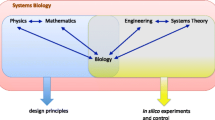Teaser
“I think that philosophy (and a specific philosophical paradigm) is exactly what differentiates systems biology from closely related sciences such as molecular biology and computational biology. Indeed, some people think that systems biology is just a kind of molecular biology - let us say a quantified (computationally based) version of molecular biology – or, on the contrary, that systems biology is just a version of computational biology. I think that a certain philosophical paradigm is what makes systems biology different from these closely related sciences. I believe that systems biology represents a shift in the way we conceptualize systems rather than an extension of previous approaches.”
Access this chapter
Tax calculation will be finalised at checkout
Purchases are for personal use only
Similar content being viewed by others
References
Alberghina, L., & Westerhoff, H. V. (Eds.). (2005). Systems biology: Definitions and perspectives. New York: Springer.
Allen, G. F., Toth, R., James, J., & Ganley, I. G. (2013). Loss of iron triggers PINK1/Parkin-independent mitophagy. EMBO Report, 14, 1127–1135.
Boogerd, F. C., Bruggeman, F., Hofmeyr, J. H. S., & Westerhoff, H. V. (Eds.). (2007). Systems biology. Philosophical foundations. Amsterdam: Elsevier.
Ciapaite, J., Van Eikenhorst, G., Bakker, S. J. L., Diamant, M., Heine, R. J., Wagner, M. J., … Krab, K. (2005). Modular kinetic analysis of the adenine nucleotide translocator-mediated effects of palmitoyl-CoA on the oxidative phosphorylation in isolated rat liver mitochondria. Diabetes, 54, 944–951.
Einstein, A. (1961). Relativity. New York: Crown Publishers.
Fell, D. A., & Wagner, A. (2000). The small world of metabolism. Nature Biotechnology, 18, 1121–1122.
Glansdorff, P., Nicolis, G., & Prigogine, I. (1974). The thermodynamic stability theory of non-equilibrium States. Proceedings of the National Academy of Sciences of the Unites States of America, 71, 197–199.
Kolodkin, A. N., & Westerhoff, H. V. (2011). Parsimony for systems biology: Shaving Occam’s razor away. European Communications in Mathematical and Theoretical Biology, 14, 149–152.
Kolodkin, A., Boogerd, F. C., Plant, N., Bruggeman, F. J., Goncharuk, V., Lunshof, J., … Westerhoff, H. V. (2011). Emergence of the silicon human and network targeting drugs. European Journal of Pharmaceutical Sciences, 46, 190–197.
Kolodkin, A., Simeonidis, E., Balling, R., & Westerhoff, H. (2012). Understanding complexity in neurodegenerative diseases: In silico reconstruction of emergence. Frontiers in Physiology, 3, 291.
Kolodkin, A., Simeonidis, E., & Westerhoff, H. V. (2013). Computing life: Add logos to biology and bios to physics. Progress in Biophysics and Molecular Biology, 111, 69–74.
Lehrach, H., Subrak, R., Boyle, P., Pasterk, M., Zatloukal, K., Müller, H., … Westerhoff, H. V. (2011). ITFoM – The IT future of medicine. Procedia Computer Science, 7, 26–29.
Mitchell, P. (1961). Coupling of phosphorylation to electron and hydrogen transfer by a chemi-osmotic type of mechanism. Nature, 191, 144–148.
Noble, D. (2006). The music of life. Biology beyond genes. Oxford: Oxford University Press.
Prigogine, I., & Nicolis, G. (1989). Exploring complexity: An introduction. New York: WH Freeman.
Schommers, W., & Espagnat, B. d. (1989). Quantum theory and pictures of reality foundations, interpretations, and new aspects. Berlin: Springer.
Snoep, J. L., & Olivier, B. G. (2002). Java Web Simulation (JWS); A web based database of kinetic models. Molecular Biology Reports, 29, 259–263.
Stephan, A. (2006). The dual role of ‘emergence’ in the philosophy of mind and in cognitive science. Synthese, 151, 485–498.
Sun, Y. H., Chen, S. P., Wang, Y. P., Hu, W., & Zhu, Z. Y. (2005). Cytoplasmic impact on cross-genus cloned fish derived from transgenic common carp (Cyprinus carpio) nuclei and goldfish (Carassius auratus) enucleated eggs. Biology of Reproduction, 72, 510–515.
Thorburn, W. M. (1918). The myth of Occam’s razor. Mind, 27, 345–353.
Tian, Q., Price, N. D., & Hood, L. (2012). Systems cancer medicine: Towards realization of predictive, preventive, personalized and participatory (P4) medicine. Journal of Internal Medicine, 271, 111–121.
Westerhoff, H. V., & Van Dam, K. (1987). Thermodynamics and control of biological free energy transduction. Amsterdam: Elsevier.
Westerhoff, H. V., Kolodkin, A., Conradie, R., Wilkinson, S. J., Bruggeman, F. J., Krab, K., … Snoep, J. L. (2009a). Systems biology towards life in silico: Mathematics of the control of living cells. Journal of Mathematical Biology, 58, 7–34.
Westerhoff, H. V., Winder, C., Messiha, H., Simeonidis, E., Adamczyk, M., Verma, M., … Dunn, W. (2009b). Systems biology: The elements and principles of life. FEBS Letters, 583, 3882–3890.
Westerhoff, H. V., Brooks, A. N., Simeonidis, E., Garcia-Contreras, R., He, F., Boogerd, F. C., … Kolodkin, A. (2014). Macromolecular networks and intelligence in microorganisms. Frontiers of Microbiology, 5, 379.
Suggested Readings by Alexey Kolodkin
Kolodkin, A. N., & Westerhoff, H. V. (2011). Parsimony for systems biology: Shaving Occam’s razor away. European Communications in Mathematical and Theoretical Biology, 14, 149–152.
Kolodkin, A., Boogerd, F. C., Plant, N., Bruggeman, F. J., Goncharuk, V., Lunshof, J., … Westerhoff, H. V. (2011). Emergence of the silicon human and network targeting drugs. European Journal of Pharmaceutical Sciences, 46, 190–197.
Kolodkin, A., Simeonidis, E., & Westerhoff, H. V. (2013). Computing life: Add logos to biology and bios to physics. Progress in Biophysics and Molecular Biology, 111, 69–74.
Author information
Authors and Affiliations
Corresponding author
Editor information
Editors and Affiliations
Rights and permissions
Copyright information
© 2017 Springer International Publishing AG
About this chapter
Cite this chapter
Kolodkin, A. (2017). Systems Biology Through the Concept of Emergence. In: Green, S. (eds) Philosophy of Systems Biology. History, Philosophy and Theory of the Life Sciences, vol 20. Springer, Cham. https://doi.org/10.1007/978-3-319-47000-9_17
Download citation
DOI: https://doi.org/10.1007/978-3-319-47000-9_17
Published:
Publisher Name: Springer, Cham
Print ISBN: 978-3-319-46999-7
Online ISBN: 978-3-319-47000-9
eBook Packages: Religion and PhilosophyPhilosophy and Religion (R0)




